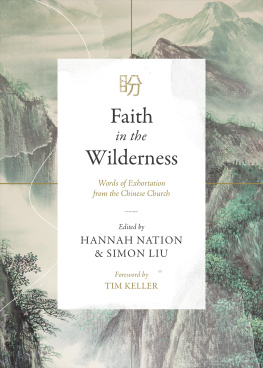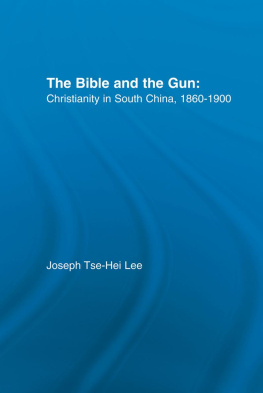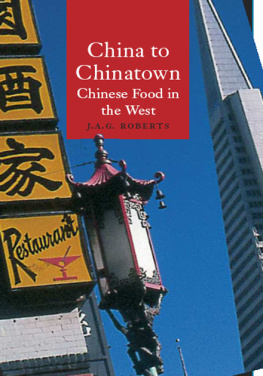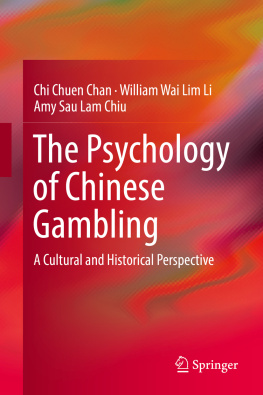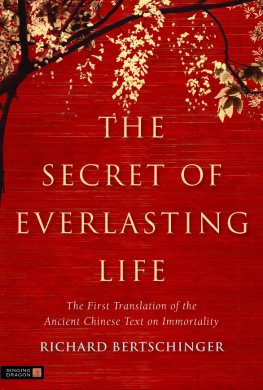The Translation of the Bible into Chinese
The Origin and Unique Authority of the Union Version
Ann Cuian Peng
The Translation of the Bible into Chinese
The Origin and Unique Authority of the Union Version
Studies in Chinese Christianity
Copyright 2021 Ann Cuian Peng. All rights reserved. Except for brief quotations in critical publications or reviews, no part of this book may be reproduced in any manner without prior written permission from the publisher. Write: Permissions, Wipf and Stock Publishers, W. th Ave., Suite , Eugene, OR 97401 .
Pickwick Publications
An Imprint of Wipf and Stock Publishers
W. th Ave., Suite
Eugene, OR 97401
www.wipfandstock.com
paperback isbn: 978-1-5326-7566-9
hardcover isbn: 978-1-5326-7567-6
ebook isbn: 978-1-5326-7568-3
Cataloguing-in-Publication data:
Names: Peng, Ann Cuian, author .
Title: The translation of the Bible into Chinese : the origin and unique authority of the Union Version / Ann Cuian Peng .
Description: Eugene, OR: Pickwick Publications, 2021. | Studies in Chinese Christianity. | Includes bibliographical references and index.
Identifiers: isbn 978-1-5326-7566-9 ( paperback ). | isbn 978-1-5326-7567-6 ( hardcover ). | isbn 978-1-5326-7568-3 ( ebook ).
Subjects: LCSH: BibleChineseVersions. | Bible translation. | Chinese Bible. | ChristianityChina.
Classification: BS315 C59 P46 2021 ( paperback ). | BS315 ( ebook ).
09/17/15
Unless otherwise noted Scripture quotations in English are taken from the New Revised Standard Version Bible copyright 1989 National Council of the Churches of Christ in the United States of America. Used by permission. All rights reserved worldwide.
Scripture quotations in English marked (ERV) are taken from the English Revised Version ( 1885 ), in the public domain.
To
Unknown Chinese scholars and assistants
who labored along with the missionary translators
whose names are in
the Book of Life
To
All who made sacrificial efforts
to provide the Union Version
for the Chinese people
Illustrations and Sources
Figure : The top of the Nestorian Tablet |
Figure : Morrison and his two Chinese Assistants |
Figure : Schereschewsky with his two Assistants in his study |
Figure : Mandarin Union Version (NT) Translators with their Chinese Assistants |
Figure : Wenli Union Version Translators with their Chinese Assistants |
Figure : Mandarin Union Version (OT) Translators with their Chinese Assistants |
Figure : Wenli Union Version 1919 |
Figure : Mandarin Union Version |
All are courtesy of the Yale Divinity School Library, New Haven, Connecticut, with the exception of figure , which is courtesy of the American Bible Society Library, New York, and figure , which was designed by the author.
Preface
A fter completing my MA at the University of Birmingham in 1991 , I attended a one-month course in the Holy Land. One day, we visited a church where, according to legend, Jesus mother Mary had visited Elizabeth. On the wall of the surrounding churchyard, the Magnificat, Marys song of praise, was written in forty-seven languages. Our tutor asked us, a group of twelve people from seven different countries, to find our own language version of the Magnificat and read it aloud in turn. I quickly scanned the various languages on the wall, doubting that I would see Chinese. I was thrilled when my eyes were caught by some Chinese characters. I had learned the Magnificat before ever attending seminary; I could have recited it by heart, and I even knew how to sing it. To my surprise, as I stared at the Chinese characters, I realized that I could not read them easily. Is this really the Chinese version? I wondered as I stuttered over the words. This was my first experience reading biblical verses in a classical style.
A few months later, on my way back to China from England, I had the opportunity to visit the American Bible Society library in New York. Although I am a third generation Christian, I had been unaware that there were other versions of the Chinese Bible besides the Chinese Union Version until I saw the Wenli (classical Chinese) version in the library. I was surprised to learn that there are in fact many Chinese versions of the Bible. How did the Bible come to China and become Chinese? I wondered. At that moment, my desire to study the formation of the Chinese Bible began.
This desire continued to grow during my time as a theology teacher and Director of the Commission on Bible Publication at the China Christian Council . I dreamed that one day I could do more scholarly research to explore the origin of the Chinese Bible. The more I read the Chinese Bible, the stronger this interest grew, especially as I became involved in revising the section headings of the Union Version. Finally, in 2001 , I had the opportunity to return to Birmingham University to fulfill my dream. The present study is the result of that long-cherished aspiration.
As 2019 recently marked the th anniversary of the Chinese Union Version of the Bible, I have been encouraged to make a contribution to the celebration by updating my research on the subject. In honor of those who dedicated their lives to the task of creating the Chinese Union Version, I undertook this project.
Acknowledgments
M y hearty gratitude goes first to Dr. G. Wright Doyle and Dr. Carol Lee Hamrin for their understanding of my research, scholarly comments, consistent encouragement, invaluable advice, and warm fellowship and friendship.
I would like to thank those who made their archives available to me, especially the British and Foreign Bible Society Library, in Cambridge; the American Bible Society Library in New York; the library at Regents Park College in Oxford; the School of Oriental and African Studies in London; the Orchard Centre Library of the University of Birmingham; and the Day Mission Library at Yale Divinity School in New Haven, Connecticut.
I want to express my appreciation to Laura Mason, and to Stephanie and Kittie Helmick who helped with English style and patiently edited my work.
Finally, I wish to acknowledge my thanks to members of my family who are in China, and to brothers and sisters in Christ, near and far, for it is they who instilled in me the tenacity of spirit, and sustained me with their constant prayers that has helped me to achieve my goals. But to no one do I owe more than to my dear husband, Yading, for his understanding, patience and love, which encouraged me and supported me throughout this study. It is sufficient to say that he has been even more delighted than I am to see the task completed. So, for that, as for so much more, I am deeply grateful.
Note on Language
T he system for Romanizing Chinese characters known as pinyin has been employed in italics throughout this study, except for proper names. In the case of quoted materials, older variants have been retained.
A few place names, because of their common usage in English, have not been rendered into pinyin ; notably, Hong Kong, Macao, Mongolia. Names like Peking (Beijing) and Nanking (Nanjing) remain in the old style in this historical study about the nineteenth century in China. The English translations, if not noted otherwise, are by the present author.
Abbreviations
Bible Versions
CNET | Chinese New English Translation Bible |
CCB | Chinese Contemporary Bible |



